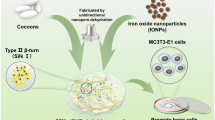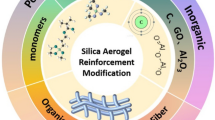Abstract
The organic–inorganic hybrid systems based on biopolymer hydrogels with dispersed silica nanoparticles were obtained and characterized in terms of their physicochemical properties, cytocompatibility and bioactivity. The hybrid materials were prepared in a form of collagen and collagen–chitosan sols to which the silica nanoparticles of two different sizes were incorporated. The ability of these materials to undergo in situ gelation under physiological temperature was assessed by microviscosity and gelation time determination based on steady-state fluorescence anisotropy measurements. The effect of silica nanoparticles addition on the physicochemical properties (surface wettability, swellability) of hybrid materials was analyzed and compared with those characteristic for pristine collagen and collagen–chitosan hydrogels. Biological studies indicate that surface wettability determined in terms of contact angle for all of the hybrids prepared is optimal and thus can provide satisfactory adhesion of fibroblasts. Cytotoxicity test results showed high metabolic activity of mouse as well as human fibroblast cell lines cultured on hybrid materials. The composition of hybrids was optimized in terms of concentration of silica nanoparticles. The effect of silica on the formation of bone-like mineral structures on exposition to simulated body fluid was determined. SEM images revealed mineral phase formation not only at the surfaces but also in the whole volumes of all hybrid materials developed suggesting their usefulness for bone tissue engineering. EDS and FTIR analyses indicated that these mineral phases consist of apatite-like structures.












Similar content being viewed by others
References
Lin D, Yang K, Tang W, Liu Y, Yuan Y, Liu C. A poly(glycerol sebacate)-coated mesoporous bioactive glass scaffold with adjustable mechanical strength, degradation rate, controlled-release and cell behavior for bone tissue engineering. Colloids Surf B. 2015;131:1–11.
Pon-On W, Charoenphandhu N, Teerapornpuntakit J, Thongbunchoo J, Krishnamra N, Tang I-M. Mechanical properties, biological activity and protein controlled release by poly(vinyl alcohol)–bioglass/chitosan–collagen composite scaffolds: a bone tissue engineering applications. Mater Sci Eng C. 2015;38:63–72.
Jin H-H, Kim D-H, Kim T-W, Shin K-K, Jung JS, Park H-C, Yoon S-Y. In vivo evaluation of porous hydroxyapatite/chitosan–alginate composite scaffolds for bone tissue engineering. Int J Biol Macromol. 2012;51:1079–85.
Morawska-Chochol A, Jaworska J, Chlopek J, Kasperczyk J, Dobrzyński P, Paluszkiewicz C, Bajor G. Degradation of poly(lactide-co-glycolide) and its composites with carbon fibres and hydroxyapatite in rabbit femoral bone. Pol Degrad Stab. 2011;96:719–26.
Nouri-Felekori M, Sheikh-Mehdi Mesgar A, Mohammadi Z. Development of composite scaffolds in the system of gelatin-calcium phosphate whiskers/fibrous spherulites for bone tissue engineering. Ceram Int. 2015;41:6013–9.
Wu S, Liu X, Yeung KWK, Liu C, Yang X. Biomimetic porous scaffolds for bone tissue engineering. Mater Sci Eng R. 2014;80:1–36.
El-Fiqi A, Lee JH, Lee E-J, Kim H-W. Collagen hydrogels incorporated with surface-aminated mesoporous nanobioactive glass: improvement of physicochemical stability and mechanical properties is effective for hard tissue engineering. Acta Biomater. 2013;9:9508–21.
Leonor IB, Baran ET, Kawashita M, Reis RL, Kokubo T, Nakamura T. Growth of a bonelike apatite on chitosan microparticles after a calcium silicate treatment. Acta Biomater. 2008;4:1349–59.
Tan J, Marra KG. Injectable, biodegradable hydrogels for tissue engineering applications. Materials. 2010;3:1746–67.
Kokubo T, Takadama H. How useful is SBF in predicting in vivo bone bioactivity? Biomaterials. 2006;27:2907–15.
Fujibayashi S, Neo M, Kim H-M, Kokubo T, Nakamura T. A comparative study between in vivo bone ingrowth and in vitro apatite formation on Na2O–CaO–SiO2 glasses. Biomaterials. 2003;24:1349–56.
Leonor IB, Balas F, Kawashita M, Reis RL, Kokubo T, Nakamura T. Biomimetic apatite deposition on polymeric microspheres treated with a calcium silicate solution. J Biomed Mater Res B Appl Biomater. 2009;91:239–47.
Ko Y-M, Lee K, Kim B-Y. Bone like apatite formation on modified Ti surfaces with COOH, NH2, and OH functional groups by plasma polymerization. Thin Solid Films. 2012;521:128–31.
Takadama H, Kim HM, Kokubo T, Nakamura T. TEM-EDX study of mechanism of bonelike apatite formation on bioactive titanium metal in simulated body fluid. J Biomed Mater Res. 2001;57:441–8.
Kokubo T, Kim HM, Kawashita M. Novel bioactive materials with different mechanical properties. Biomaterials. 2003;24:2161–75.
Lewandowska-Łańcucka J, Fiejdasz S, Rodzik Ł, Kozieł M, Nowakowska M. Bioactive hydrogel-nanosilica hybrid materials: a potential injectable scaffold for bone tissue engineering. Biomed Mater. 2015;. doi:10.1088/1748-6041/10/1/015020.
Stöber W, Fink A, Bohn E. Controlled growth of monodisperse silica spheres in the micron size range. J Colloid Interface Sci. 1968;26:62–9.
Fiejdasz S, Szczubiałka K, Lewandowska-Łańcucka J, Osyczka AM, Nowakowska M. Biopolymer-based hydrogels as injectable materials for tissue repair scaffolds. Biomed Mater. 2013;. doi:10.1088/1748-6041/8/3/035013.
Lewandowska-Łańcucka J, Staszewska M, Szuwarzyński M, Kępczyński M, Romek M, Tokarz W, Kania G, Szpak A, Nowakowska M. Synthesis and characterization of the superparamagnetic iron oxide nanoparticles modified with cationic chitosan and coated with silica shell. J Alloy Compd. 2014;586:45–51.
Li X, Chang J. Preparation of bone-like apatite–collagen nanocomposites by a biomimetic process with phosphorylated collagen. J Biomed Mater Res A. 2008;85:293–300.
Bruni S, Cariati F, Casu M, Lai A, Musinu A, Piccaluga G, Solinas S. IR and NMR study of nanoparticle-support interactions in a Fe2O3–SiO2 nanocomposite prepared by a Sol–gel method. Nanostruct Mater. 1999;11:573–86.
Lakowicz JR. Principles of fluorescence spectroscopy. New York: Plenum Press; 1983.
Marchi MC, Bilmes SA, Negri RM. Microviscosity in the cavities of titania gels studied by steady-state fluorescence anisotropy. Langmuir. 1997;13:3665–73.
Beddard GS, Doust T, Porter G. Picosecond fluorescence depolarisation measured by requency conversion. Chem Phys. 1981;61:17–23.
Dutt GB, Doraiswamy S, Periasamy N, Venkataraman B. Rotational reorientation dynamics of polar dye molecular probes by picosecond laser spectroscopic technique. J Chem Phys. 1990;93:8498–513.
Fu SY, Feng XQ, Lauke B, Mai YW. Effects of particle size, particle/matrix interface adhesion and particle loading on mechanical properties of particulate–polymer composites. Compos B Eng. 2008;39:933–61.
Alvarez GS, Hélary C, Mebert AM, Wang X, Coradin T, Desimone MF. Antibiotic-loaded silica nanoparticle–collagen composite hydrogels with prolonged antimicrobial activity for wound infection prevention. J Mater Chem B. 2014;2:4660–70.
Chen S, Chinnathambi S, Shi X, Osaka A, Zhu Y, Hanagata N. Fabrication of novel collagen-silica hybrid membranes with tailored biodegradation and strong cell contact guidance ability. J Mater Chem. 2012;22:21885–92.
Jing S, Jiang D, Wen S, Wang J, Yang C. Preparation and characterization of collagen/silica composite scaffolds for peripheral nerve regeneration. J Porous Mater. 2014;21:699–708.
Tamada Y, Ikada Y. Fibroblast growth on polymer surfaces and biosynthesis of collagen. J Biomed Mater Res. 1994;28:783–9.
Hou Y, Matthews AR, Smitherman AM, Bulick AS, Hahn MS, Hou H, Han A, Grunlan MA. Thermoresponsive nanocomposite hydrogels with cell-releasing behavior. Biomaterials. 2008;29:3175–84.
Anselme K. Osteoblast adhesion on biomaterials. Biomaterials. 2000;21:667–81.
Altankov G, Groth T. Reorganization of substratum-bound fibronectin on hydrophilic and hydrophobic materials is related to biocompatibility. J Mater Sci Mater Med. 1994;5:732–7.
Wei J, Yoshinari M, Takemoto S, Hattori M, Kawada E, Liu B, Oda Y. Adhesion of mouse fibroblasts on hexamethyldisiloxane surfaces with wide range of wettability. J Biomed Mater Res B Appl Biomater. 2007;81:66–75.
Tamada Y, Ikada Y. Effect of preadsorbed proteins on cell adhesion to polymer surfaces. J Colloid Interface Sci. 1993;155:334–9.
Scudiero DA, Shoemaker RH, Paull KD, Monks A, Tierney S, Nofziger TH, Curren MJ, Seniff D, Boyd MR. Evaluation of a soluble tetrazolium formazan assay for cell growth and drug sensitivity in culture using human and other tumor cell lines. Cancer Res. 1988;48:4827–33.
Takadama H, Kim HM, Kokubo T, Nakamura T. X-ray photoelectron spectroscopy study on the process of apatite formation on a sodium silicate glass in simulated body fluid. J Am Ceram Soc. 2002;85:1933–6.
Raghavan RN, Muthukumar T, Somanathan N, Sastry TP. Biomimetic mineralization of novel silane crosslinked collagen. Mater Sci Eng C Mater Biol Appl. 2013;33:1983–8.
Song J, Saiz E, Bertozzi CR. A new approach to mineralization of biocompatible hydrogel scaffolds: an efficient process toward 3-dimensional bonelike composites. J Am Chem Soc. 2003;125:1236–43.
Błażewicz S, Stoch L. Biocybernetyka i inżynieria biomedyczna, tom 4 Biomateriały. Warszawa: Akademicka Oficyna Wydawnicza Exit; 2000.
Rajzer I, Menaszek E, Kwiatkowski R, Chrzanowski W. Bioactive nanocomposite PLDL/nano-hydroxyapatite electrospun membranes for bone tissue engineering. J Mater Sci Mater Med. 2014;25:1239–47.
Acknowledgments
Project operated within the Foundation for Polish Science Team Programme co-financed by the EU European Regional Development Fund, PolyMed, TEAM/2008-2/6.
Author information
Authors and Affiliations
Corresponding author
Rights and permissions
About this article
Cite this article
Lewandowska-Łańcucka, J., Fiejdasz, S., Rodzik, Ł. et al. Novel hybrid materials for preparation of bone tissue engineering scaffolds. J Mater Sci: Mater Med 26, 231 (2015). https://doi.org/10.1007/s10856-015-5564-6
Received:
Accepted:
Published:
DOI: https://doi.org/10.1007/s10856-015-5564-6




